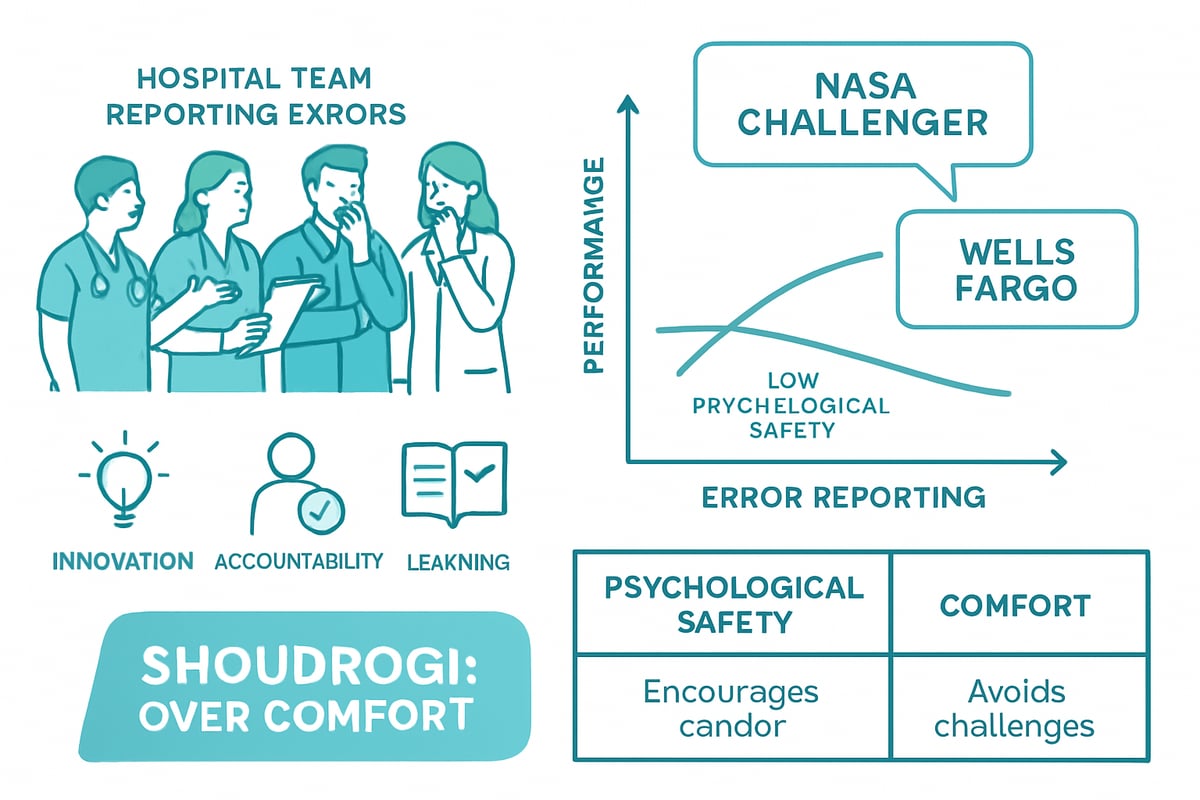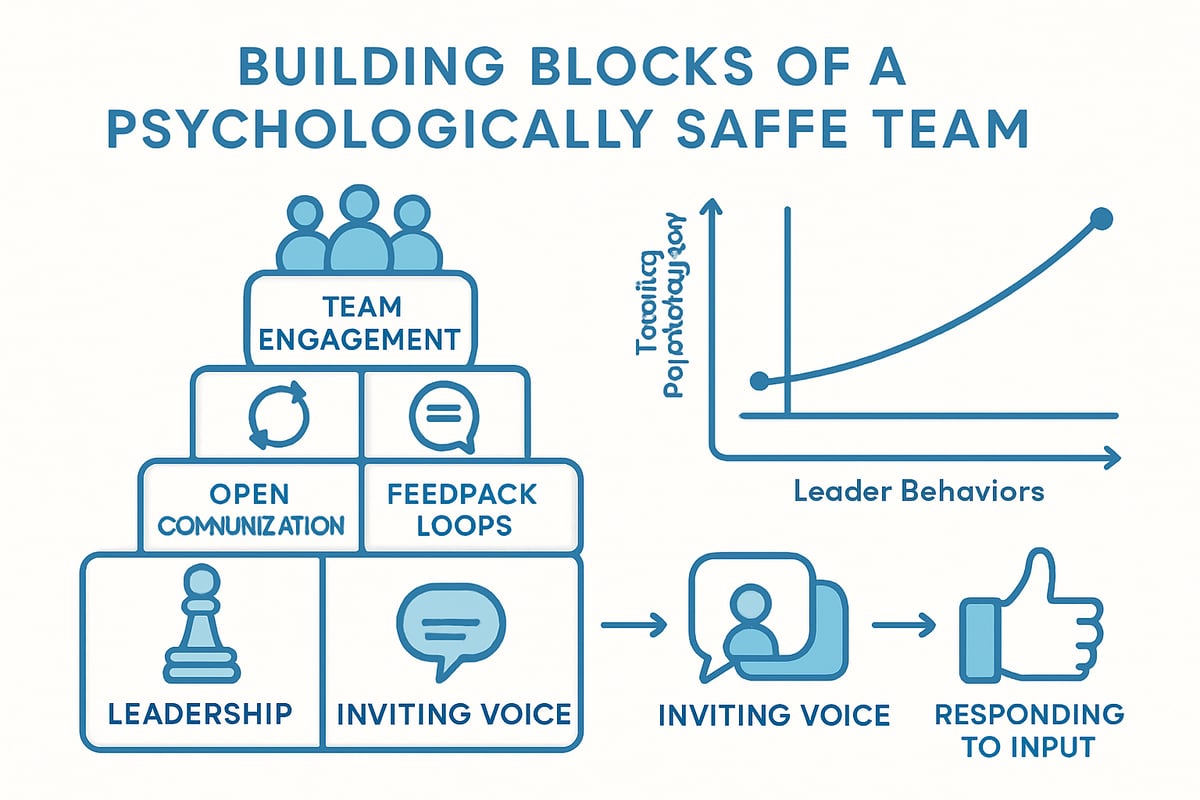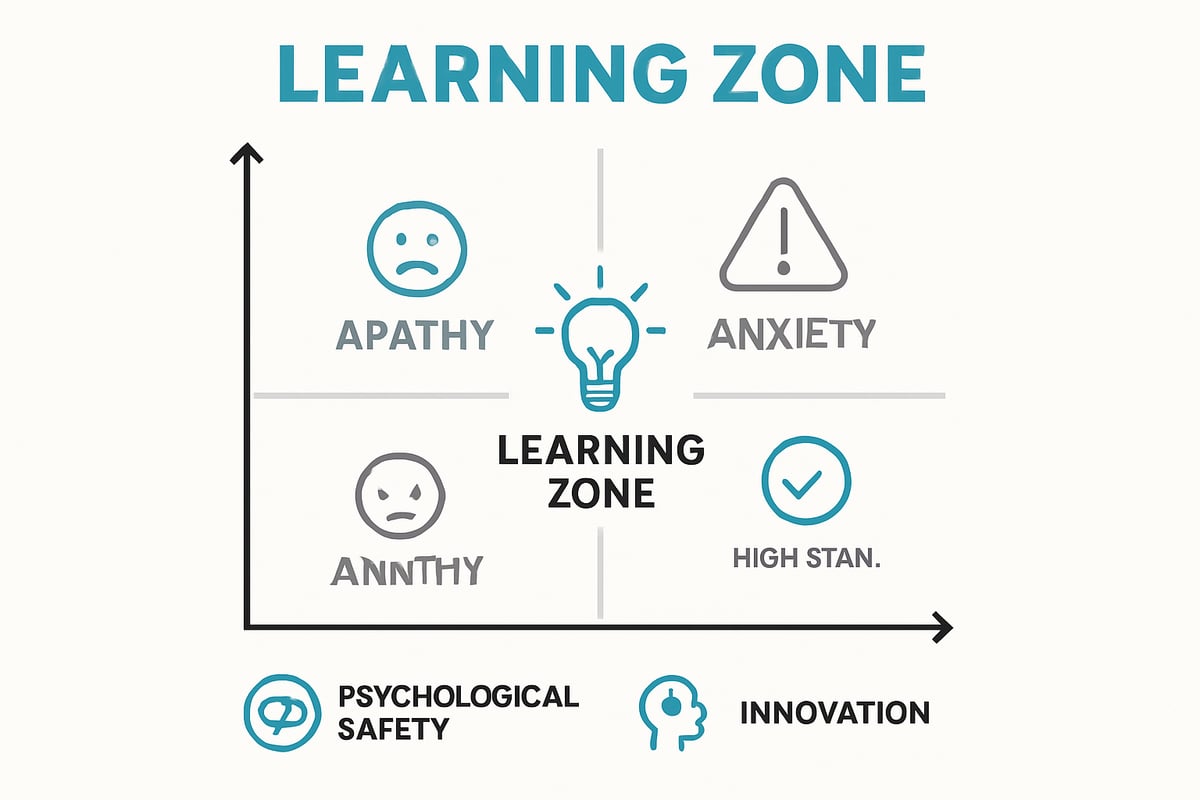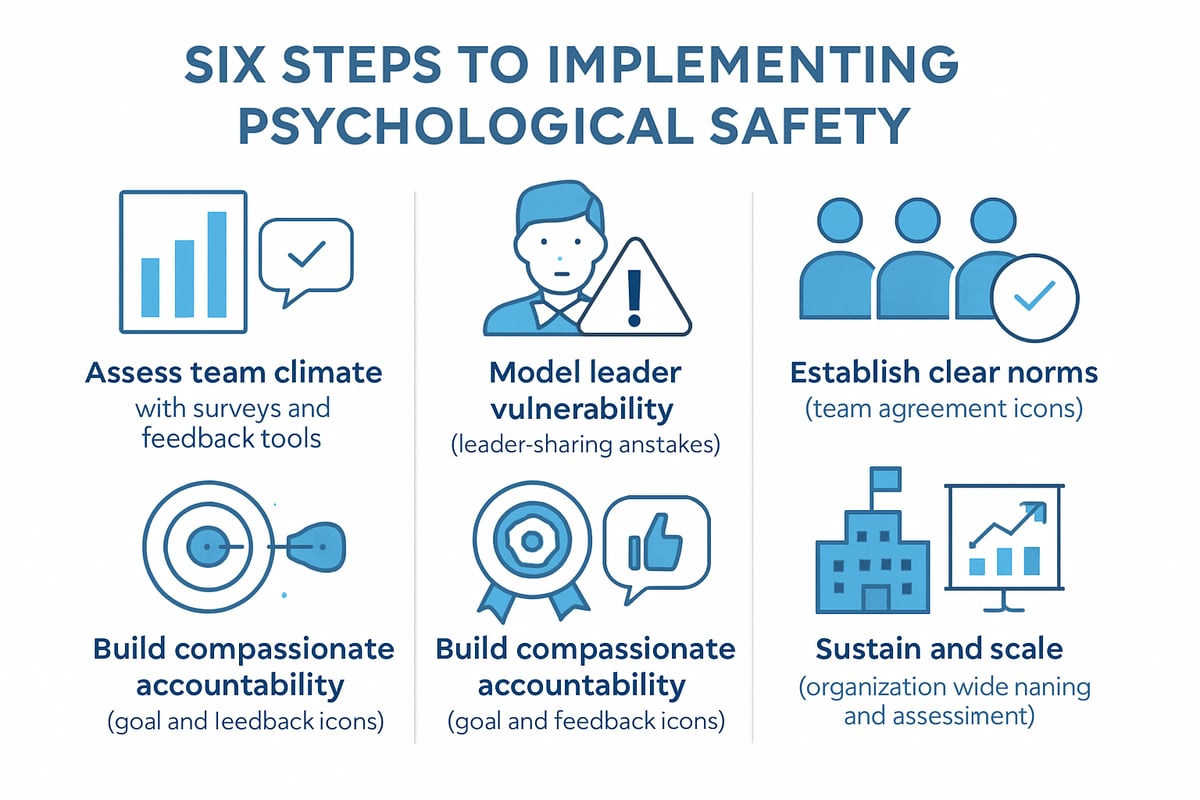Amy Edmondson Psychological Safety Guide for Leaders 2025
In today’s rapidly changing workplace, leaders face mounting pressure to adapt and empower their teams. The concept of amy edmondson psychological safety stands at the forefront, providing a proven path to higher performance, innovation, and resilience. This guide draws from Edmondson’s latest research to equip leaders with actionable frameworks, real-world strategies, and step-by-step actions for building cultures where trust and open dialogue drive results. Explore the essential principles, discover why psychological safety matters more than ever in 2025, and learn how to lead teams to measurable success. For further leadership insights, see Accountability Now.
Understanding Psychological Safety: Amy Edmondson’s Foundational Insights
The concept of psychological safety has become a cornerstone for leaders aiming to unlock high performance and resilience in their teams. At its core, psychological safety means that employees feel safe to share ideas, raise concerns, and admit mistakes without fear of negative consequences. This belief, central to amy edmondson psychological safety research, is what empowers teams to learn, innovate, and adapt.

Defining Psychological Safety and Its Impact
Amy edmondson psychological safety is defined as the shared belief that a team is safe for interpersonal risk taking. Edmondson’s landmark studies in hospitals revealed that teams with high psychological safety reported more errors, but actually performed better because open communication allowed them to learn and improve. This counterintuitive finding challenged the assumption that fewer reported errors meant better performance.
It is crucial to distinguish between psychological safety and comfort. While comfort suggests a lack of challenge, psychological safety enables the “healthy friction” necessary for growth. Teams can engage in honest debates and constructive conflict, leading to better solutions and stronger outcomes.
Table: Psychological Safety vs. Comfort
| Aspect | Psychological Safety | Comfort |
|---|---|---|
| Feedback | Honest and constructive | Minimal or avoided |
| Mistake Response | Viewed as learning opportunity | Ignored or downplayed |
| Debate | Encouraged, respectful challenge | Rare, avoided |
| Growth | High, continuous improvement | Stagnant |
Real-world failures like the NASA Challenger disaster and the Wells Fargo scandal highlight what happens when psychological safety is absent. In both cases, employees hesitated to speak up, resulting in catastrophic outcomes.
Importantly, psychological safety is not about being “nice.” It is about creating an environment where people can give and receive honest feedback, learn from errors, and hold each other accountable. For a foundational overview, see Psychological Safety Explained.
The Business Case for Psychological Safety in 2025
As organizations face rising complexity and rapid change, amy edmondson psychological safety is more critical than ever. Modern workplaces are increasingly hybrid, cross-functional, and diverse, which introduces both new opportunities and new challenges for team dynamics.
Research shows that companies with high levels of psychological safety consistently outperform peers in innovation, employee engagement, and retention. Teams that feel safe to share ideas adapt more quickly to change, recover from setbacks, and deliver better results. This adaptability is essential for leaders managing distributed or remote teams.
A common misconception is that psychological safety lowers performance standards or encourages complacency. In reality, the opposite is true. Amy edmondson psychological safety supports high standards by making it possible to address mistakes openly and to hold one another accountable for results.
Leaders who prioritize psychological safety foster cultures of continuous improvement, where learning and accountability go hand in hand. This foundation enables organizations to thrive in the evolving workplace, where uncertainty is the only constant. To explore practical frameworks for accountability, visit this resource.
The Leader’s Role: Building Blocks of a Psychologically Safe Team
Creating a culture of amy edmondson psychological safety starts with leadership. Leaders set the tone for how teams communicate, innovate, and handle mistakes. The foundation for a psychologically safe workplace is built one conversation at a time. Let’s break down the essential leadership actions that foster trust, learning, and high performance.

Framing the Work and Setting Expectations
At the heart of amy edmondson psychological safety is the leader’s ability to frame work in a way that highlights both purpose and risk. Leaders must make it clear that everyone’s input matters and that mistakes are not just possible but expected in complex environments.
By acknowledging their own fallibility, leaders invite others to contribute without fear. Amy Edmondson recommends leaders say, “I may miss something—please speak up if you see an issue.” This simple admission lowers barriers and encourages openness.
Medical teams exemplify this approach by openly discussing potential errors before patient care begins. This transparency helps prevent harm and builds collective responsibility.
Leaders should also set high standards while reinforcing psychological safety. There is no need to choose between excellence and openness. In fact, teams achieve the best results when both are present.
For more actionable steps, review the Four Steps to Building Psychological Safety which outlines proven leadership behaviors.
Inviting Engagement and Encouraging Voice
Driving amy edmondson psychological safety requires leaders to actively invite participation from all team members. It’s not enough to be open; leaders must proactively seek out questions, concerns, and feedback.
Techniques that foster engagement include:
- Asking open-ended questions in meetings.
- Holding regular debriefs after projects or incidents.
- Recognizing and celebrating contributions, no matter how small.
Accessibility and approachability are critical. Leaders who are visible and approachable create an environment where team members feel comfortable speaking up.
Overcoming hierarchy is another key challenge. Empowering junior staff to share ideas or concerns ensures that valuable perspectives are not lost. In healthcare, cross-disciplinary teams that encourage open dialogue have shown measurable improvements in patient outcomes.
Here’s a summary table of leader behaviors that build psychological safety:
| Behavior | Impact |
|---|---|
| Ask open questions | Increases input |
| Debrief regularly | Promotes reflection |
| Recognize voice | Builds confidence |
When leaders model these behaviors, amy edmondson psychological safety becomes woven into the team’s daily habits.
Responding Productively to Input
The way leaders respond to input is a true test of amy edmondson psychological safety. When team members share ideas or admit mistakes, leaders should respond with appreciation and curiosity, not defensiveness.
Punitive reactions drive silence and fear. Instead, leaders should focus on learning and solutions. Organizations that celebrate “good catches” and encourage sharing of near-misses foster an atmosphere where learning trumps blame.
Consistent, constructive feedback builds trust over time. When team members see that their voices lead to positive action, they become more engaged and committed.
By responding productively, leaders reinforce that psychological safety and accountability go hand in hand. The result is a team that takes risks, learns quickly, and consistently outperforms.
Psychological Safety and Accountability: Striking the Essential Balance
Balancing psychological safety with accountability is at the heart of the amy edmondson psychological safety approach. Many leaders worry that fostering openness might lower standards, but Edmondson’s research shows the opposite. High-performing teams thrive when they feel safe to voice concerns and also know what is expected of them.
This essential balance helps organizations avoid costly mistakes and drive continuous improvement. By understanding the interplay between psychological safety and accountability, leaders can create environments where both people and results matter.

Debunking the Myth: Safety vs. Accountability
A common misconception is that psychological safety undermines accountability. In reality, amy edmondson psychological safety research proves these qualities reinforce each other. When team members feel safe to speak up, they are more willing to admit mistakes, share feedback, and discuss performance gaps openly.
Accountability is not about blame. It is about setting clear expectations and supporting people to meet them. When psychological safety is present, teams can discuss challenges without fear. This transparency leads to better solutions and fewer repeated errors.
In Edmondson’s studies, high-safety teams admitted more errors, but they learned and adapted faster. This honest communication is crucial for organizations facing complexity and rapid change.
Creating Healthy Friction and Productive Conflict
Psychological safety does not mean avoiding conflict. Instead, amy edmondson psychological safety principles encourage respectful disagreement and diverse perspectives. Healthy friction is the spark that drives innovation and improvement.
In high-safety teams, members challenge each other’s assumptions and bring unique viewpoints to the table. This kind of debate leads to stronger decisions and greater creativity. Leaders should invite constructive dissent and model curiosity, making it okay to question the status quo.
Examples from healthcare, tech, and aviation show that teams who embrace healthy conflict outperform those who silence dissent. Productive debates keep teams sharp, focused, and ready for future challenges.
Practical Frameworks for Leaders
Amy edmondson psychological safety is best achieved when leaders use structured models. Edmondson’s “Learning Zone” framework shows that optimal performance comes from combining high standards with high psychological safety.
Here’s a summary:
| Zone | Psychological Safety | Accountability | Results |
|---|---|---|---|
| Learning Zone | High | High | Growth, Success |
| Anxiety Zone | Low | High | Stress, Burnout |
| Comfort Zone | High | Low | Stagnation |
| Apathy Zone | Low | Low | Disengagement |
Leaders can use tools like regular feedback sessions and anonymous surveys to assess their teams. For more details on implementing these frameworks, see Psychological Safety at Work. Building the right balance also means recognizing team efforts and holding individuals accountable with compassion. For advanced insights on accountability, visit accountabilitynow.net.
With the right approach, leaders can drive both trust and results, making psychological safety and accountability the foundation of long-term success.
Step-by-Step Guide: Implementing Psychological Safety in Your Organization
Building psychological safety is not a one-time fix. It requires deliberate, ongoing action. The amy edmondson psychological safety framework provides a proven roadmap. By following these steps, you lay the groundwork for trust, innovation, and lasting performance.

Step 1: Assess Your Team’s Current Climate
Begin by measuring your team’s current psychological safety. Use tools like Edmondson’s Team Diagnostic Survey or pulse surveys to gather honest feedback. Anonymous responses are essential to surface hidden concerns.
Look for patterns in communication, trust, and willingness to speak up. Compare results across teams or time periods to spot progress or persistent gaps. For more detailed strategies, visit Team Psychological Safety Practices.
A table can clarify your findings:
| Assessment Tool | What It Measures | Frequency |
|---|---|---|
| Team Diagnostic Survey | Safety, learning, voice | Quarterly |
| Anonymous Pulse Survey | Trust, engagement, barriers | Monthly |
By starting with data, you set a baseline for amy edmondson psychological safety improvements.
Step 2: Model Vulnerability and Openness as a Leader
Leaders must set the tone. Share your own mistakes and learning experiences openly. This signals that imperfection is safe and expected.
Admit when you do not have all the answers. Invite team members to contribute ideas and solutions. When leaders demonstrate vulnerability, others follow suit.
Storytelling is powerful. In town halls or meetings, use personal examples to illustrate lessons learned. When you embody the principles of amy edmondson psychological safety, your team feels empowered to do the same.
Step 3: Establish Clear Norms for Speaking Up
Co-create team agreements that encourage candor and respectful challenge. Make it explicit that every voice matters, regardless of role or tenure.
Use structured check-ins and inclusive meeting practices. For example, try a “round-robin” format where everyone shares feedback or ideas. Set expectations early, especially with new hires.
Document these norms and revisit them regularly. When clear standards exist, amy edmondson psychological safety becomes embedded in daily routines.
Step 4: Recognize and Reward Constructive Dissent
Actively acknowledge team members who raise concerns or suggest improvements. Recognition can be public or private, but it must be genuine.
Create channels for anonymous reporting and ensure follow-up. Celebrate learning from failures, not just successes. Hospitals, for example, use “Good Catch” awards for those who prevent errors.
Rewarding dissent signals that speaking up is valued. This reinforces amy edmondson psychological safety and builds a learning culture.
Step 5: Build Accountability with Compassion
Set clear goals and performance metrics for your team. Provide regular, actionable feedback focused on growth, not blame.
When issues arise, address them through coaching and support rather than fear. High standards and psychological safety are not mutually exclusive. They form the foundation for excellence.
Use checklists or progress dashboards to track objectives. This approach, grounded in amy edmondson psychological safety, ensures accountability while fostering trust.
Step 6: Sustain and Scale Psychological Safety
Integrate psychological safety into onboarding, training, and leadership development. Monitor progress with ongoing assessments and adjust strategies as needed.
Share best practices across teams and celebrate wins. Embed psychological safety into your organization’s core values and evaluation criteria.
For organizations seeking strategic support, partnering with experienced advisors such as those at AccountabilityNow.net can strengthen these efforts.
When amy edmondson psychological safety is woven into the fabric of your company, it becomes self-sustaining. This unlocks long-term innovation, resilience, and engagement.
Overcoming Barriers: Common Challenges and How to Address Them
In the journey to embed amy edmondson psychological safety within organizations, leaders must anticipate and navigate several persistent barriers. Each challenge requires a tailored approach, grounded in research and practical experience, to foster lasting change.
Navigating Hierarchy and Power Dynamics
Hierarchical structures can silence valuable voices, especially from junior team members. To advance amy edmondson psychological safety, leaders must actively break down these barriers.
- Rotate meeting facilitators to empower different voices.
- Explicitly invite input from all levels, not just senior staff.
- Encourage open questioning in forums such as patient safety rounds.
Leadership behavior sets the tone. For a deeper exploration of how toxic leadership undermines psychological safety, see the Effects of Toxic Leadership on Safety. Addressing power dynamics head-on helps prevent silence and promotes learning.
Addressing Cultural and Generational Differences
Cultural and generational backgrounds shape how team members express dissent or challenge authority. Amy edmondson psychological safety requires recognizing and respecting these differences.
- Provide cultural competence training tailored to your workforce.
- Adapt communication styles to suit multicultural and multigenerational teams.
- Share examples from multinational firms successfully adapting frameworks globally.
By valuing diverse perspectives, organizations unlock greater innovation and trust.
Managing Resistance and Fear of Change
Change initiatives can trigger skepticism or anxiety about repercussions. Employees may doubt leadership’s commitment to amy edmondson psychological safety or fear retaliation.
- Build trust through transparent communication and consistent follow-through.
- Share both successes and setbacks in safety culture efforts.
- Offer confidential channels for feedback and reporting.
For practical resources on building accountability while supporting psychological safety, visit Accountability Now. When leaders demonstrate persistence and empathy, resistance decreases and engagement rises.
Sustaining Momentum in Remote and Hybrid Workplaces
Remote and hybrid environments can erode informal communication and trust, posing new challenges for amy edmondson psychological safety.
- Schedule regular virtual check-ins to maintain connection.
- Use digital platforms for anonymous feedback and recognition.
- Ensure leaders maintain a visible presence, even from a distance.
Distributed teams thrive when psychological safety is intentionally woven into daily routines and communication channels.
Measuring Progress and Demonstrating ROI
To secure ongoing leadership support, it is essential to track outcomes of amy edmondson psychological safety initiatives.
- Use data to monitor engagement, retention, and performance.
- Share success stories and tangible results to reinforce value.
- Report improvements, such as lower turnover or increased innovation, post-implementation.
Measurement fosters accountability and helps ensure psychological safety becomes a sustained part of organizational culture.
Future Trends: Psychological Safety in the Evolving Workplace (2025 and Beyond)
As we look ahead to 2025 and beyond, amy edmondson psychological safety is set to become even more critical. The workplace is transforming rapidly, demanding fresh approaches to trust, collaboration, and leadership. Let’s break down what leaders can expect and how they can stay ahead.
The Rise of Hybrid and Distributed Teams
The shift to remote and hybrid work is here to stay. For leaders, this means rethinking how they foster amy edmondson psychological safety when teams are spread across locations. Physical distance can erode spontaneous communication and trust, so organizations need intentional strategies.
- Schedule regular virtual check-ins.
- Use digital platforms for anonymous feedback.
- Establish clear communication norms.
A strong culture of psychological safety is essential for distributed teams to thrive, adapt, and feel included.
AI, Automation, and the Human Element
Technology is reshaping how teams operate. AI tools and automation streamline tasks, but they also change team dynamics. Leaders must balance the efficiency of automation with the empathy that amy edmondson psychological safety demands.
- Use AI-powered pulse surveys to monitor team climate.
- Combine data-driven insights with human connection.
- Train managers to interpret tech feedback with care.
According to Amy Edmondson’s 2025 Psychological Safety Keynote, embracing technology should never mean losing the human touch.
Diversity, Equity, and Inclusion (DEI) Synergy
Amy edmondson psychological safety is the foundation for effective DEI. In diverse workplaces, safety allows all voices to be heard, especially those from underrepresented groups. Leaders should link psychological safety metrics to DEI outcomes and adapt strategies globally.
- Leverage cultural competence training.
- Encourage respectful debate and challenge to authority.
- Adapt frameworks for different regions.
Organizations that prioritize DEI and psychological safety together see stronger engagement and innovation.
Continuous Learning and Adaptation
Industries are evolving, making lifelong learning a must. Amy edmondson psychological safety empowers teams to experiment, learn from mistakes, and adapt quickly. High-reliability organizations in healthcare and energy already model this approach.
- Foster a culture of curiosity and experimentation.
- Celebrate lessons learned as much as successes.
- Integrate psychological safety into development programs.
For more on building accountability and learning, explore resources at accountabilitynow.net.
Leadership Competencies for 2025
Future-ready leaders need new skills to champion amy edmondson psychological safety. Empathy, digital fluency, adaptability, and cross-cultural communication are non-negotiable. Development programs now embed psychological safety as a core leadership competency.
- Invest in empathy and feedback training.
- Prepare leaders to navigate uncertainty and complexity.
- Encourage open dialogue at every level.
The leaders who master these competencies will build resilient, high-performing teams—ready for whatever the future holds.




Leave a Reply
Want to join the discussion?Feel free to contribute!